Synaptics Bundle
How has the Synaptics SWOT Analysis shaped the tech landscape?
Ever wondered how we went from clunky keyboards to sleek touchscreens? The story of Synaptics, a pivotal player in human interface solutions, is a journey of innovation that has fundamentally changed how we interact with technology. From its humble beginnings in 1986, Synaptics has consistently pushed the boundaries of what's possible, making technology more accessible and intuitive for everyone. This brief history of Synaptics unveils the key milestones and innovations that have shaped its remarkable trajectory.
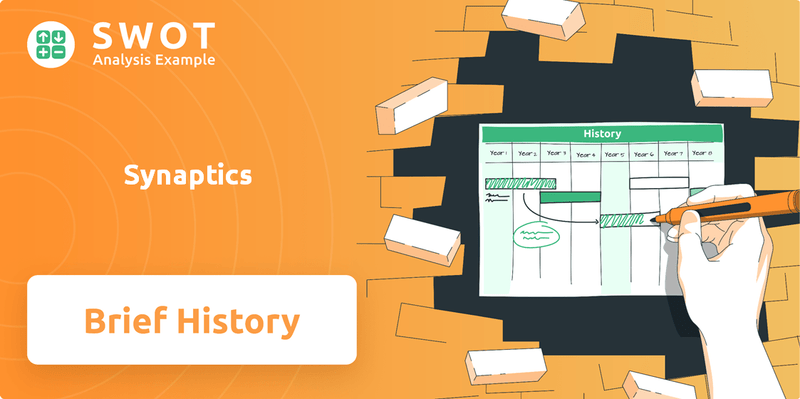
Synaptics' early focus on human-computer interfaces, particularly its pioneering work with the touchpad, marked the beginning of its influence on the tech world. The Synaptics SWOT Analysis reveals the company's strategic adaptability, allowing it to thrive in a competitive market. Today, Synaptics technology is integral to numerous devices, from laptops to smart home gadgets, continuously evolving with the integration of AI and machine learning to enhance user experiences. Understanding the Synaptics history is crucial for grasping the evolution of consumer electronics and the growing demand for intuitive interfaces.
What is the Synaptics Founding Story?
The story of the Synaptics company began on March 17, 1986. The company was founded by Federico Faggin and Carver Mead. Their combined expertise in semiconductors and neural networks set the stage for Synaptics' initial focus on intelligent interfaces, marking a pivotal moment in the evolution of human-computer interaction.
The founders recognized a problem: existing human-computer interfaces were often difficult to use. They envisioned a more intuitive and 'human-centric' approach. Their initial business model centered on advanced input solutions that mimicked human sensory perception. This vision led to the development of touch-sensitive surfaces that could interpret complex human gestures.
The name 'Synaptics' was chosen to reflect the company's focus on 'synapses' – the connections in the brain that enable learning and information processing. This choice aligned with their vision for intelligent and adaptive interfaces. Initial funding came from venture capital, leveraging the founders' reputations in the tech sector. The mid-1980s Silicon Valley environment provided a strong foundation for a company focused on enhancing human-computer interaction.
Synaptics was founded in 1986 by Federico Faggin and Carver Mead, aiming to improve human-computer interaction.
- The company's name, Synaptics, reflects its focus on brain-inspired interfaces.
- Initial funding came from venture capital, supported by the founders' strong reputations.
- The company's early focus was on creating advanced input solutions, like touch-sensitive surfaces.
- The founding coincided with the rapid growth of the personal computer market in Silicon Valley.
Synaptics SWOT Analysis
- Complete SWOT Breakdown
- Fully Customizable
- Editable in Excel & Word
- Professional Formatting
- Investor-Ready Format
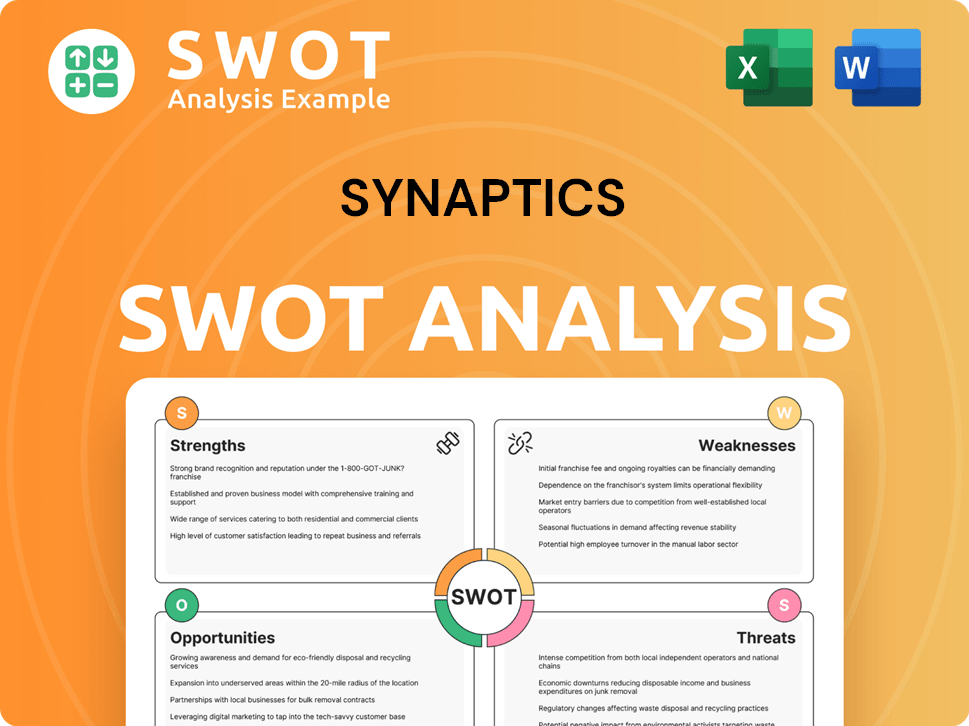
What Drove the Early Growth of Synaptics?
The early growth of the Synaptics company was fueled by its pioneering work in capacitive sensing technology, which became the foundation for its touchpads. This innovation marked a significant turning point for the company. The introduction of its touchpads into laptop computers in the early 1990s, particularly with partnerships like Apple, significantly boosted its profile and market penetration, establishing Synaptics as a leader in intuitive input solutions.
As the laptop market expanded, so did Synaptics. The company grew its team beyond its initial core of engineers to include sales, marketing, and manufacturing support. Early office locations were primarily in Silicon Valley, fostering collaboration. This expansion was critical for handling increased demand and developing new Synaptics products.
Synaptics strategically entered new markets by adapting its touchpad Synaptics technology for various applications, including industrial controls. While specific early acquisitions aren't widely publicized, the company consistently invested in R&D. This investment helped maintain its technological edge and allowed it to introduce further Synaptics innovations.
The market reception for Synaptics touchpads was overwhelmingly positive, offering a superior alternative to traditional trackballs. The competitive landscape saw Synaptics quickly emerge as a dominant force due to its technology and strategic partnerships. The success of Synaptics also influenced its Marketing Strategy of Synaptics.
This period saw Synaptics transition from an R&D firm to a product-focused company, solidifying its business model around licensing its technology and selling integrated solutions. By 2000, Synaptics touchpads were integrated into a significant percentage of all laptops shipped globally, highlighting its market penetration. This shift was crucial for its long-term success and growth.
Synaptics PESTLE Analysis
- Covers All 6 PESTLE Categories
- No Research Needed – Save Hours of Work
- Built by Experts, Trusted by Consultants
- Instant Download, Ready to Use
- 100% Editable, Fully Customizable
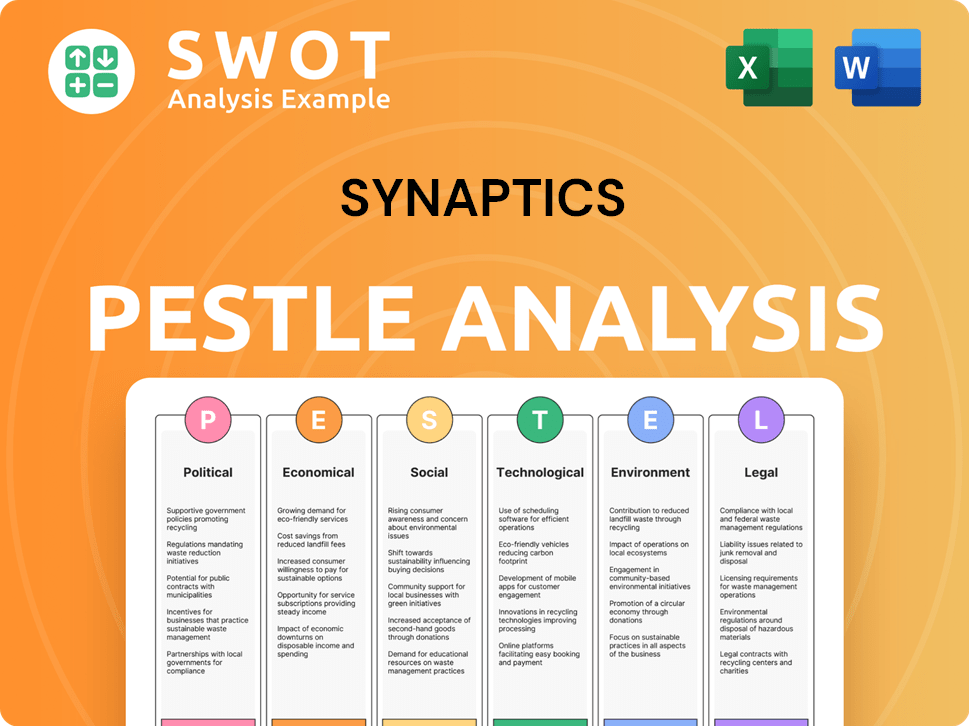
What are the key Milestones in Synaptics history?
The Synaptics company has a rich Synaptics history, marked by significant milestones that have shaped the human-machine interface landscape. From its early days to its current position, Synaptics has consistently pushed the boundaries of Synaptics technology, achieving several key accomplishments along the way.
| Year | Milestone |
|---|---|
| 1986 | Synaptics was founded, marking the beginning of its journey in human interface solutions. |
| 1994 | Introduced the industry's first capacitive touchpad, revolutionizing laptop navigation. |
| 1999 | Synaptics went public with its IPO, marking a significant step in its growth. |
| 2013 | Acquired Validity Sensors, expanding its biometric offerings. |
| 2023 | Synaptics continues to innovate in display driver and IoT markets. |
Synaptics has been at the forefront of Synaptics innovations. The company's advancements in touch technology, including force-sensing touchpads and multi-finger gesture recognition, have changed how users interact with their devices. These Synaptics products have become integral to modern computing and mobile devices.
The introduction of the capacitive touchpad in 1994 was a groundbreaking innovation. This technology quickly became the standard for laptop navigation, replacing older trackball and pointing stick solutions.
Synaptics developed force-sensing touchpads that added another dimension of interaction. This allowed users to perform actions based on the pressure they applied, enhancing the user experience.
The company pioneered multi-finger gesture recognition, enabling intuitive actions like pinch-to-zoom and two-finger scrolling. This improved the usability of touch-enabled devices.
Synaptics expanded into biometric solutions with fingerprint sensors. These sensors provided secure authentication for mobile devices and other applications.
Synaptics has developed display drivers for various devices. This technology ensures optimal display performance and visual quality in smartphones, tablets, and other devices.
The company's human interface solutions cover a range of technologies, including touch, display, and biometric sensors. These solutions enhance the user experience across various devices.
Despite its successes, Synaptics has faced several challenges throughout its Synaptics history. Market downturns and intense competition have required the company to adapt and innovate continuously. Understanding the target market of Synaptics is crucial for navigating these challenges.
Economic downturns, such as the dot-com bubble and the 2008 financial crisis, impacted Synaptics' revenue and growth. These events required strategic adjustments to maintain financial stability.
Competition from rival sensor manufacturers and alternative input methods has necessitated continuous innovation. Synaptics has had to evolve its product offerings to stay ahead.
The rapid pace of technological change has meant that products must evolve quickly to avoid obsolescence. This requires significant investment in research and development.
Recent supply chain disruptions have presented challenges for Synaptics. The company has addressed these through strategic acquisitions and a focus on high-growth areas.
Synaptics faces intense competition in the display driver and IoT markets. This requires the company to differentiate its products and services to maintain its market share.
As the smartphone market surged, Synaptics diversified beyond touchpads into touchscreen controllers and fingerprint sensors. This strategic pivot was crucial for maintaining relevance and growth.
Synaptics Business Model Canvas
- Complete 9-Block Business Model Canvas
- Effortlessly Communicate Your Business Strategy
- Investor-Ready BMC Format
- 100% Editable and Customizable
- Clear and Structured Layout
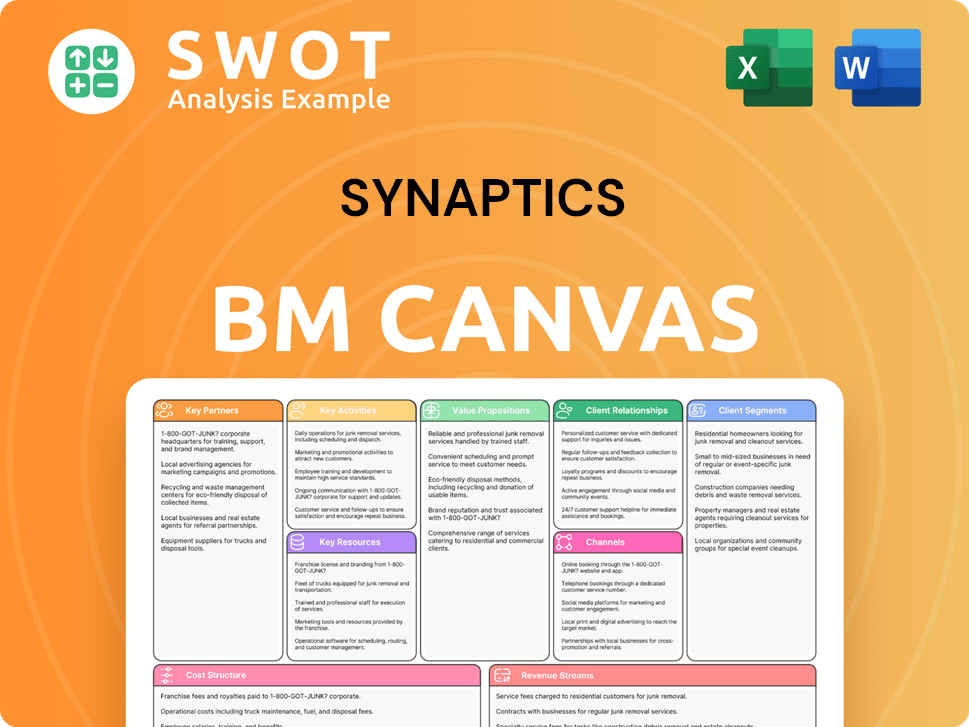
What is the Timeline of Key Events for Synaptics?
The brief history of Synaptics (Synaptics company) showcases its evolution from a startup to a leader in human interface solutions. The company's journey is marked by significant technological advancements and strategic acquisitions, shaping its presence in the tech industry. This journey is detailed further in the article Owners & Shareholders of Synaptics.
| Year | Key Event |
|---|---|
| 1986 | Synaptics was founded, marking the beginning of its journey in human interface technology. |
| 1999 | The company went public, entering the public market and gaining access to broader financial resources. |
| 2000s | Synaptics expanded its product offerings and market presence, focusing on touchpads and touchscreens. |
| 2010s | The company continued to innovate, developing advanced display and human interface solutions for mobile devices and other applications. |
| 2020s | Synaptics has focused on expanding its product portfolio to include audio and video solutions, as well as focusing on IoT. |
Synaptics is increasingly focusing on the Internet of Things (IoT) market. This involves developing solutions for smart home devices, wearables, and industrial applications. The company aims to capitalize on the growing demand for connected devices and anticipates significant growth in this sector. This strategic move aligns with the broader tech industry trends.
The company continues to invest in display driver technology, aiming to enhance visual experiences across various devices. This includes developing solutions for high-resolution displays, OLED screens, and innovative display features. These advancements are crucial for maintaining a competitive edge in the display market. This is especially important in the mobile sector.
Synaptics may pursue strategic acquisitions to broaden its product portfolio and expand its market reach. This could involve acquiring companies with complementary technologies or entering new market segments. Acquisitions are a common strategy for accelerating innovation and gaining a competitive advantage. This is a common practice in the tech industry.
The company's financial performance and market share will be critical indicators of its success. As of the latest financial reports, the company's revenue and profitability are key metrics to watch. Maintaining or growing its market share in the competitive human interface and display solutions market is a key objective for Synaptics. The company's ability to innovate and adapt to market changes will be key.
Synaptics Porter's Five Forces Analysis
- Covers All 5 Competitive Forces in Detail
- Structured for Consultants, Students, and Founders
- 100% Editable in Microsoft Word & Excel
- Instant Digital Download – Use Immediately
- Compatible with Mac & PC – Fully Unlocked
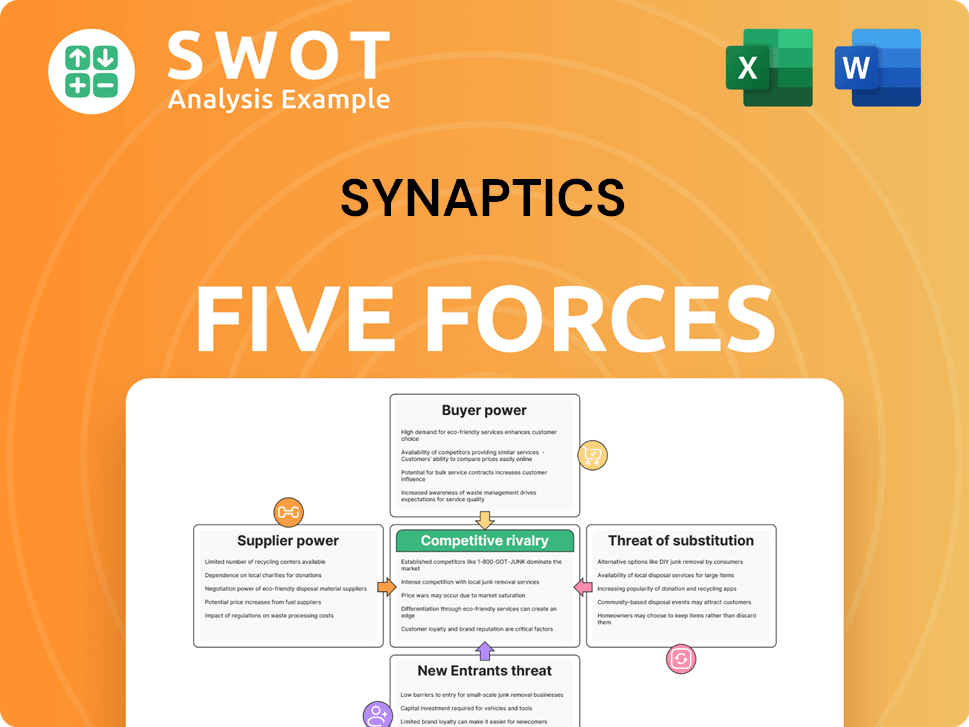
Related Blogs
- What is Competitive Landscape of Synaptics Company?
- What is Growth Strategy and Future Prospects of Synaptics Company?
- How Does Synaptics Company Work?
- What is Sales and Marketing Strategy of Synaptics Company?
- What is Brief History of Synaptics Company?
- Who Owns Synaptics Company?
- What is Customer Demographics and Target Market of Synaptics Company?
Disclaimer
All information, articles, and product details provided on this website are for general informational and educational purposes only. We do not claim any ownership over, nor do we intend to infringe upon, any trademarks, copyrights, logos, brand names, or other intellectual property mentioned or depicted on this site. Such intellectual property remains the property of its respective owners, and any references here are made solely for identification or informational purposes, without implying any affiliation, endorsement, or partnership.
We make no representations or warranties, express or implied, regarding the accuracy, completeness, or suitability of any content or products presented. Nothing on this website should be construed as legal, tax, investment, financial, medical, or other professional advice. In addition, no part of this site—including articles or product references—constitutes a solicitation, recommendation, endorsement, advertisement, or offer to buy or sell any securities, franchises, or other financial instruments, particularly in jurisdictions where such activity would be unlawful.
All content is of a general nature and may not address the specific circumstances of any individual or entity. It is not a substitute for professional advice or services. Any actions you take based on the information provided here are strictly at your own risk. You accept full responsibility for any decisions or outcomes arising from your use of this website and agree to release us from any liability in connection with your use of, or reliance upon, the content or products found herein.